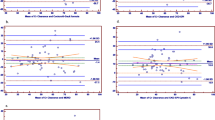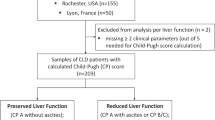Abstract
Background
Hepatitis B virus (HBV) infection is a public health challenge, especially in China. In clinical practice, HBV infection is associated with nephropathy. Impaired renal function is frequently observed in compensated Chronic Hepatitis B (CHB) and cirrhosis (LC). Thus, renal function must be monitored to avoid nephrotoxic effects before and during nucleoside analog treatment. Investigating the predictive markers of early renal dysfunction is essential. New GFR-predicting equations, based on Pcr and/or CystC, have been recently recommended in the general population, but their performance in liver disease patients has been rarely studied. In this study, we will discuss how to detect renal dysfunction in patients with HBV infection.
Methods
A total of 16 LC patients and 23 CHB patients were enrolled in this study, and we collected and compared the clinical data of the two groups. The estimated glomerular filtration rates (eGFRs) were also calculated by several equations. All patients received 99mTc-DTPA dynamic radionuclide imaging examinations to obtain mGFRs as the reference standard. To evaluate the performance of any equation in the CHB and LC groups, paired t test, Pearson’s correlation, Kappa analysis and Bland–Altman plots were utilized. Moreover, all 39 subjects were divided into two groups (according to GFR > 90 mL/min/1.73 m2). We compared the serum and urinary markers of kidney injury between the two groups and selected the indicators of renal injury by univariate analysis.
Results
The mGFR was 72.26 ± 20.69 mL/min/1.73 m2 in the LC group, and 87.49 ± 25.91 mL/min/1.73 m2 in the CHB group. The paired t test results of eGFR and mGFR showed no difference between eGFR (estimated by the CHINAcr-cys equation) and mGFR (p > 0.05) in the compensated LC and CHB groups. The difference between mGFR and eGFR estimated by other methods was obvious (p < 0.05). Comparing the eGFRs (estimated by 5 different equations) with mGFR in the compensated LC and CHB groups, Pearson’s correlation showed that only eGFR (estimated by the CHINAcr-cys equation) had a significant correlation coefficient in CHB (r = 0.678, p = 0.000) and had the highest R2 (R2 = 0.459) among all other measures. The kappa consistency test showed that eGFR from CHINAscr-cys had poor consistency with mGFR in the compensated LC group but moderate consistency in the CHB group. Bland–Altman consistency analysis showed that in the CHB group, the CHINAcr-cys and CKD-EPIcr equations presented narrower acceptable limits than did the aMDRD, c-aMDRD, and CKD-EPIcr-cys equations (62.8, 56.1 vs .85.7, 102.9, 93.6 mL/min per 1.73 m2). In the compensated LC group, the CHINAcr-cys and CKD-EPIcr equations presented narrower acceptable limits than did the aMDRD, c-aMDRD, and CKD-EPIcr-cys equations (83.6, 81.3 vs. 98, 113.5, 106.3 mL/min per 1.73 m2). Serum or urinary markers were compared with renal function (GFR > 90 mL/min/1.73 m2) and showed International normalized ratio (INR) (p = 0.009), creatinine (p = 0.006), urine N-acetyl-β-glucosaminidase (NAG) (p = 0.001) and serum cystatin C (CysC) (p = 0.044).
Conclusion
The CHINAcr-cys equation may be more suitable for the estimation of GFR in Chinese patients with CHB or compensated cirrhosis. INR, creatinine, NAG, and CysC are proper biomarkers for screening renal dysfunction in Chinese patients with CHB or compensated LC.








Similar content being viewed by others
References
Deterding K, Lampe N, Reijnders J, Manns MP, Janssen H, Zoulim F, Buti M, Santantonio T, Wedemeyer H (2011) 366 Prevalence and severity of kidney dysfunction in patients with chronic hepatitis B in Europe: data from the European Virgil Cohort. J Hepatol 54(Suppl 1):S147–S147
Ha NB, Ha NBGarcia RT (2009) Renal dysfunction in chronic hepatitis B patients treated with adefovir dipivoxil. Hepatology 50(3):727–734
Liu Y, Fan R, Chen J, Zheng Z, Liao B, Liang X, Yin J, Zhou Q, Sun J (2014) Assessment of renal function and risk factors for renal impairment in patients with hepatitis B virus-related liver cirrhosis. J South Med Univ 34(4):472–476
Mauss S, Berger F, Filmann N, Hueppe D, Henke J, Hegener P, Athmann C, Schmutz G, Herrmann E (2011) Effect of HBV polymerase inhibitors on renal function in patients with chronic hepatitis B. J Hepatol 55(6):1235–1240
Hai LI, Han T, Yan LI, Chen LY, Wang YL, Xiang XH, Yang SG, Zhu LM (2015) The early renal injury and its related factors in patients with chronic HBV infection. Chin J Blood Purif 0(11):644–648
Gane EJ, Deray G, Liaw YF, Lim SG, Lai CL, Rasenack J, Wang Y, Papatheodoridis G, Di BA, Buti M (2014) Telbivudine improves renal function in patients with chronic hepatitis B. Gastroenterology 146(1):138–146
Hou J, Wang G, Wang F, Cheng J, Ren H, Zhuang H, Sun J, Li L, Li J, Meng Q (2017) Guideline of prevention and treatment for chronic hepatitis B (2015 update). J Clin Transl Hepatol 5(4):297–318
Ofliver EAF (2017) EASL 2017 Clinical Practice Guidelines on the management of hepatitis B virus infection. J Hepatol 67(2):370–398
Levey AS, Green T, Kuseket J, Beck G (2000) A simplified equitation to predict glomerular filtration rate from serum creatinine. J Am Soc Nephrol 11:A0828
Eknoyan G, Levin N (2001) NKF-K/DOQI clinical practice guidelines: update 2000. Foreword. Am J Kidney Dis 37(1):5–6
Levey AS, Bosch JP, Lewis JB, Greene T, Rogers N, Roth D (1999) A more accurate method to estimate glomerular filtration rate from serum creatinine: a new prediction equation. Ann Intern Med 130(6):461–470
Zuo L, Ma YC, Zhou YH, Wang M, Xu GB, Wang HY (2005) Application of GFR-estimating equations in Chinese patients with chronic kidney disease. Am J Kidney Dis 45(3):463–472
Ma YC, Zuo L, Chen JH, Luo Q, Yu XQ, Li Y, Xu JS, Huang SM, Wang LN, Huang W (2006) Modified glomerular filtration rate estimating equation for Chinese patients with chronic kidney disease. J Am Soc Nephrol Jasn 17(10):2937–2944
Levey AS, Stevens LA, Schmid CH, Zhang YL, Rd CA, Feldman HI, Kusek JW, Eggers P, Van LF, Greene T (2009) A new equation to estimate glomerular filtration rate. Ann Intern Med 150(9):604–612
Eriksen BO, Mathisen UD, Melsom T, Ingebretsen OC, Jenssen TG, Njølstad I, Solbu MD, Toft I (2010) Cystatin C is not a better estimator of GFR than plasma creatinine in the general population. Kidney Int 78(12):1305–1311
Stockman JA (2011) A new equation to estimate glomerular filtration rate. Yearb Pediatr 2011:193–194
Tent H, Rook M, Stevens LA, Son WJV, Pelt LJV, Hofker HS, Ploeg RJ, Heide JJHVD, Navis G (2010) Renal function equations before and after living kidney donation: a within-individual comparison of performance at different levels of renal function. Clin J Am Soc Nephrol 5(11):1960–1968
Earley A, Miskulin D, Lamb EJ, Levey AS, Uhlig K (2012) Estimating equations for glomerular filtration rate in the era of creatinine standardization: a systematic review. Ann Intern Med 156(11):785–795
Inker LA, Schmid CH, Tighiouart H, Eckfeldt JH, Feldman HI, Greene T, Kusek JW, Manzi J, Van LF, Zhang YL (2012) Estimating glomerular filtration rate from serum creatinine and cystatin C. N Engl J Med 367(1):20–29
Feng JF, Qiu L, Zhang L, Li XM, Yang YW, Zeng P, Guo XZ, Qin Y, Liu HC, Han XM (2013) Multicenter study of creatinine- and/or cystatin C-based equations for estimation of glomerular filtration rates in Chinese patients with chronic kidney disease. PLos ONE 8(3):e57240
Guo X, Qin Y, Zheng K, Gong M, Wu J, Shou W, Cheng X, Xia L, Xu E, Li X (2014) Improved glomerular filtration rate estimation using New equations combined with standardized cystatin C and creatinine in Chinese adult chronic kidney disease patients. Clin Biochem 47(13–14):1220–1226
Wu X, Cai S, Li Z, Zheng C, Peng J (2016) Potential effects of telbivudine and entecavir on renal function: a systematic review and meta-analysis. Virol J 13(1):64
Mindikoglu AL, Dowling TC, Weir MR, Seliger SL, Christenson RH, Magder LS (2014) Performance of chronic kidney disease epidemiology collaboration creatinine-cystatin C equation for estimating kidney function in cirrhosis. Hepatology 59(4):1532–1542
Pirlich M, Schütz T, Spachos T, Ertl S, Weiss ML, Lochs H, Plauth M (2000) Bioelectrical impedance analysis is a useful bedside technique to assess malnutrition in cirrhotic patients with and without ascites. Hepatology 32(6):1208–1215
Gonwa TA, Jennings L, Mai ML, Stark PC, Levey AS, Klintmalm GB (2004) Estimation of glomerular filtration rates before and after orthotopic liver transplantation: evaluation of current equations. Liver Transplant 10(2):301–309
Badiou S, Dupuy AM, Descomps B, Cristolead JP (2003) Comparison between the enzymatic vitros assay for creatinine determination and three other methods adapted on the Olympus analyzer. J Clin Lab Anal 17(6):235–240
Donadio C (2010) Serum and urinary markers of early impairment of GFR in chronic kidney disease patients: diagnostic accuracy of urinary β-trace protein. Am J Physiol Ren Physiol 299(6):1407–1423
Uslu S, Efe B, Alataş O, Kebapçi N, Colak O, Demirüstü C, Yörük A (2005) Serum cystatin C and urinary enzymes as screening markers of renal dysfunction in diabetic patients. J Nephrol 18(5):559–567
Adachi M, Tanaka A, Aiso M, Takamori Y, Takikawa H (2016) The benefit of cystatin c in evaluation of renal function and prediction of survival in patients with cirrhosis. Hepatol Res 45(13):1299–1306
Omar M, Abdelrazek W, Aboraia G, Assem M, Elazab G (2015) Evaluation of serum cystatin C as a marker of early renal impairment in patients with liver cirrhosis. Int J Hepatol 2015:Article ID 309042
Acknowledgements
Supported by the National Science and Technology Major Project (2016ZX10002011).
Author information
Authors and Affiliations
Contributions
SR, LZ and HL provided the ideas, and SR, HL and YC drafted the report. YC, QZ, XW, HN, LC, CL, ZZ and XX delivered experimental data. All authors have read and contributed to editing this manuscript and agree with the content and presentation of the paper.
Corresponding author
Ethics declarations
Conflict of interest
No conflicts of interest, financial or otherwise, are declared by the authors.
Additional information
Publisher’s Note
Springer Nature remains neutral with regard to jurisdictional claims in published maps and institutional affiliations.
Rights and permissions
About this article
Cite this article
Ren, S., Chang, Y., Zhang, Q. et al. How to estimate renal function in patients with liver disease: choosing the most suitable equation. Int Urol Nephrol 51, 677–690 (2019). https://doi.org/10.1007/s11255-019-02110-8
Received:
Accepted:
Published:
Issue Date:
DOI: https://doi.org/10.1007/s11255-019-02110-8




